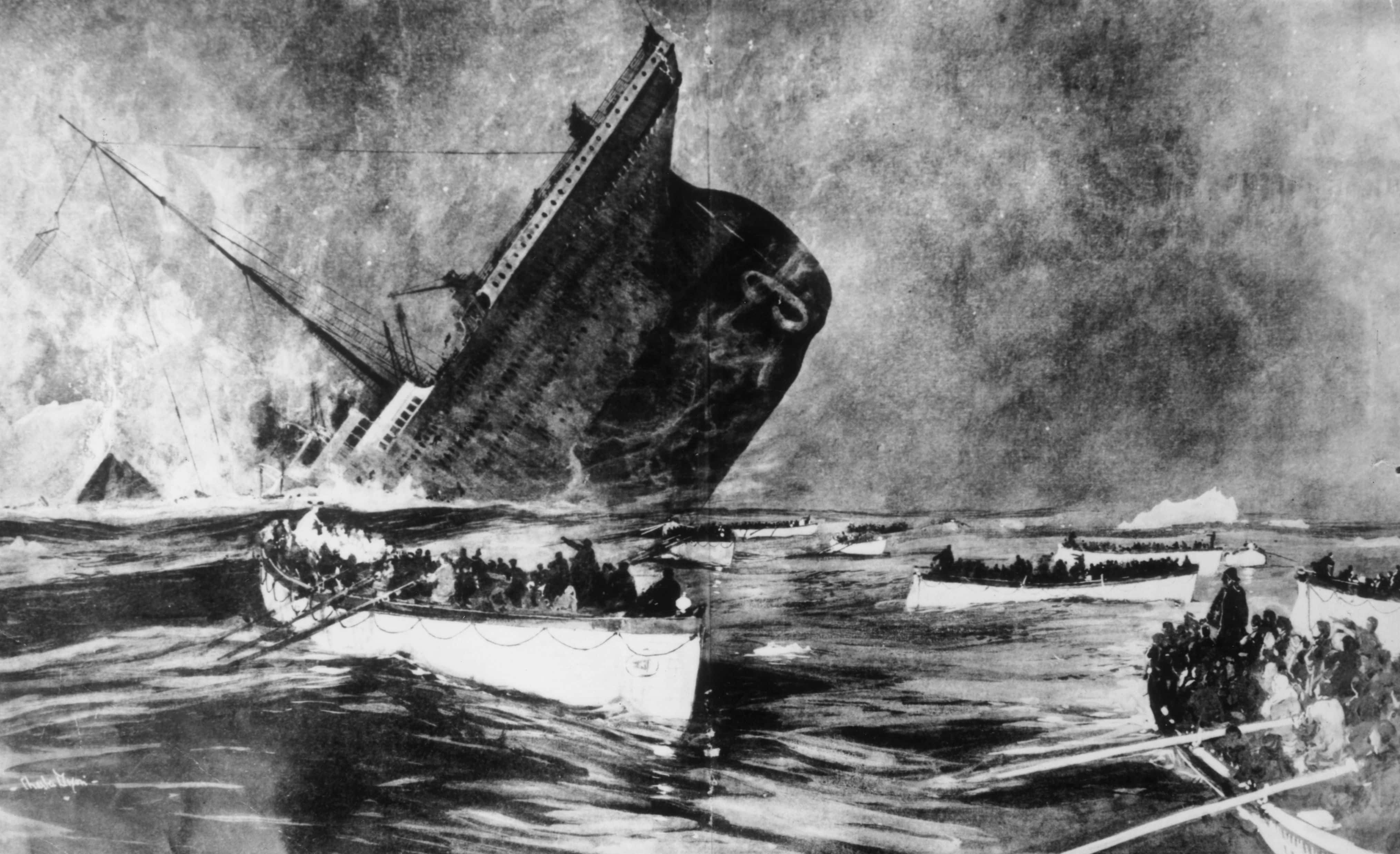“I cannot imagine any condition which would cause a ship to founder. I cannot conceive of any vital disaster happening to this vessel. Modern shipbuilding has gone beyond that.” —Captain Edward Smith, referring to Adriatic
On April 10, 1912, the Titanic, the largest ship in the water, left England on her maiden voyage to New York City. Despite being touted as the safest ship ever built, four days into the journey, on the night of April 14, the ship struck an iceberg. The ship's hull compartments were breached by the iceberg, and they filled with water, causing the bow to sink and the stern to raise up to an almost vertical position. Then the ship broke in half, and at about 2:20am on April 15, it sank into the ocean. More than 1,500 people died in the disaster. Below are 40 fatal facts about the ship and the disaster.
40. Prophetic Novel
14 years before the sinking of the Titanic, author Morgan Robertson wrote a novel called Futility. In the book, an ocean liner named Titan strikes an iceberg on her maiden voyage.
39. What Are the Odds?
In the 10 years before the Titanic disaster, White Star Line had carried 2,179,954 passengers, and only experienced two fatalities.
38. They’d Been Warned
The iceberg that the Titanic struck didn’t exactly come out of nowhere. The crew had received six ice warnings prior to the collision, all of which they ignored.
37. Intense Competition
The Titanic was the result of intense competition among shipping lines in the first half of the 20th century. In particular, the British firm Cunard had two ships that ranked among the most sophisticated luxury ships of the time, one of which set a speed record that it held for 22 years.
36. World’s Largest Passenger Ship
The Titanic was the world’s largest passenger ship at the time it was constructed. It measured 882 feet in length, and was the largest man-made moving object on Earth. Today, the passenger ship Symphony of the Seas makes it seem tiny, with a capacity of 230,000 gross tons and a measurement of 1,188 feet in length.
35. Coal Power
The Titanic burnt approximately 600 tonnes of coal per day, all of which was hand-shoveled into furnaces by 176 men. Nearly 100 tons of ash were ejected into the sea on a daily basis.
34. Ritzy
The interiors of the Titanic were loosely inspired by those of the Ritz hotel in London. The facilities included a gym, a pool, a Turkish bath, a kennel for the first-class dogs, and squash courts. The ship even had its own newspaper, The Atlantic Daily Bulletin.
33. Thirty Seven Seconds to Impact
The moment lookout Frederick Fleet spotted the iceberg to the time of impact was only 37 seconds. He rang the bell in warning and telephoned the bridge, but they were unable to avoid it.
 Titanic (1997), Twentieth Century Fox
Titanic (1997), Twentieth Century Fox
32. Should Have Kept Straight
When the chief officer on the bridge received the iceberg warning, he ordered the helmsman Robert Hichens to turn the wheel “Hard astarboard.” Researchers now believe that the ship could have been saved had the turn not been ordered. The Titanic had collision bulkheads in the bow, so the vessel would have very likely survived a head-on impact. Experts have stated that the damages from a head-on collision would have flooded the first three, or at most four, watertight compartments, which wouldn't have been enough to sink the ship.
Other experts disagree and have stated that the force of a head-on impact would have damaged the body of the ship, and potentially causes small ruptures in the central hull (in addition to the heavily damaged bow), which would have still caused the boat to ship... but much more slowly.
 Titanic (1997), Twentieth Century Fox
Titanic (1997), Twentieth Century Fox
31. A Series of Small Tears
When the Titanic sunk, it was widely believed that the iceberg had caused a 300-foot gash along the side of the ship. Once the wreck of RMS Titanic was discovered in 1985, the actual damage was clearly visible: the ship sustained six separate tears totalling just 15 square feet.
30. Two Too Many
Six forward compartments were flooded when the Titanic struck the iceberg; four was the maximum number that could flood without risk of the ship sinking.
29. 20,000 Bottles of Beer on the Wall
The Titanic had 1,500 bottles of wine, 8,000 cigars, and 20,000 bottles of beer on board. All of these were exclusively for the use of the first-class passengers.
28. Number Crunching
The cost of building the Titanic was around 7.3 million pounds at the time. A replica of the Titanic was recently planned to be built for $435 million and was set to launch in 2018. Anyone got their tickets yet? Well, don't: surprising no one, the plan for a Titanic II was abandoned.
27. Most Seen in 50 Years
In April 1912, there were 300 icebergs in the North Atlantic Shipping lanes. This was the most seen in the route between Europe and North America in half a century.
26. A Grand Staircase
The ornate staircase on board the Titanic was designed for the use of (surprise) first-class passengers. It descended five decks from the first-class entrance to the lower accommodation decks, lounges, and dining room. The staircase featured oak paneling and ironwork. The whole staircase was lit by a huge glass dome which allowed light to flow in overhead.
 Titanic (1997), Twentieth Century Fox
Titanic (1997), Twentieth Century Fox
25. One Hour Delay
There was a delay of 60 minutes from the time of collision to when the first lifeboats launched. Part of the reason for the delay was that many people believed the call to the lifeboats was a drill and stayed inside where it was warm. Once the order to launch the lifeboats was given, there was also a lot of confusion about where to go as there had not been any lifeboat drills.
24. Not Enough Time
As a result of the delay launching the first lifeboat, there was not enough time to successfully launch the remaining lifeboats. Two of the collapsible lifeboats were never actually launched, but floated away as water washed over the ship.
23. Should have Slowed Down
During the initial investigations into the cause of the Titanic disaster, captain Edward Smith was blamed for going too fast in dangerous waters. While Smith could not have predicted the amount of icebergs in the area, even after he received warning, he could have reduce the ship’s speed as a precaution.
22. Standing on Top
When Collapsible B Lifeboat floated away upside down, people tried to right it but were unsuccessful. 30 people did manage to survive by standing on top of the upturned boat.
 Titanic (1997), Twentieth Century Fox
Titanic (1997), Twentieth Century Fox
21. Fatal Flaws
The Titanic featured a double bottom and 15 watertight bulkhead compartments equipped with watertight doors. The doors could be operated individually or simultaneously by a switch on the bridge. The flaw in this design was that the walls separating the bulkheads allowed water to pour from one compartment to another—especially if the ship began to list or pitch forward. Sound familiar?
20. Not Enough
Including the crew, the ship was carrying 2,208 people. Not wanting to clutter the deck, the number of lifeboats on board was reduced to 20 fully wooden lifeboats with four collapsible lifeboats—enough for 1,488 people.
19. Useless Devices
In addition to the lifeboats, the ship was carrying 3,500 lifebelts and 48 life rings. While they did keep people from drowning, that wasn’t the cause of death for most of the passengers that night. The majority who died froze to death in the icy Atlantic waters.
 Titanic (1997), Twentieth Century Fox
Titanic (1997), Twentieth Century Fox
18. Horse Power
It took 20 horses to carry the main anchor to the Titanic. The anchor was the largest anchor ever forged by hand, and measured over 18 feet in length and weighed almost 15 tons.
17. LEGO Titanic
A Norwegian boy spent the equivalent of 16 days building a giant model Titanic out of LEGO. He used 30,000 bricks, and incorporated many of the ship’s details, from the lifeboats to the smokestacks. The structure is 2.5 feet tall and nearly 10 feet long. (If he were a purist though, he'd have it destroyed.)
16. Keeping it Smooth
3 tons of pressure per square inch was endured by the hull of the Titanic while on the slipway. It is estimated that it took 22 tons of soap, tallow (rendered beef or mutton fat), and train-oil to lubricate the slipway to ensure a smooth launch.
15. A Surprising Lack of Pomp
Contrary to what some might think, there was very little pomp attached to the launch of the Titanic. As was White Star Line’s policy, there was no champagne or a ceremonial naming of the ship. The only announcement of the ship’s launch were two rockets fired; one 15 minutes before, and one at the point of launch.
14. Not Fully Filled
When all of the lifeboats did finally leave the Titanic, they were not filled to capacity. Each boat could safely carry approximately 70 people, but senior surviving officer Charles Lightoller claimed that he could not have filled the boats to capacity without the mechanism holding them collapsing. Lifeboat 6, which was designed to hold 64 people, left with just 28 people on board.
13. Richest Man on Board
John Jacob Astor IV was the wealthiest passenger on board with a net worth of about $85 million (over $2 billion today). He was an inventor, a writer, and a builder, constructing the Astoria hotel in New York in 1897. He and his newlywed wife had been wintering abroad, and decided to return to New York as first-class passengers on board the Titanic. Astor loaded his wife onto a lifeboat but ended up going down with the ship. One report states he was seen smoking a cigarette as the ship went down.
12. Dogs on Board
First-class passengers were allowed to bring their dogs on the Titanic, and there were 12 confirmed dogs on board, including a Fox Terrier, a French Poodle, a French Bulldog, and John Jacob Astor’s Airedale, Kitty. Three of the smaller dogs were smuggled onto the lifeboats, and made it safely to New York.
11. Not Without Her Dog!
One of the most famous legends of the Titanic disaster is that of Anne Elizabeth Isham. She had been living in Europe when her brother sent a telegraph requesting that she travel to New York to spend the summer with him. Legend says that she refused to leave the ship without her beloved Great Dane, who had been deemed too big for a lifeboat. She allegedly stayed behind rather than leave him, and the body of a woman found holding a large dog is believed to have been Isham.
10. Those Who Didn’t Sail
For one reason or another, several famous people had tickets for the Titanic but didn’t sail on that fateful voyage. George W. Vanderbilt and his wife canceled because someone in their family was worried that "so many things can go wrong on a maiden voyage."
9. Unsinkable Molly Brown
Margaret Brown (aka Molly) was one of the most famous Titanic survivors, and has been portrayed on screen by Hollywood greats such as Debbie Reynolds and Kathy Bates. Brown was highly involved in the early feminist movement, and helped establish the Colorado chapter of the National American Women’s Suffrage Association. She even ran for senate in 1912, eight years before women had the right to vote in the United States. When the Titanic was sinking, she helped load the lifeboats before finally boarding lifeboat 6. On the lifeboat, she encouraged the women not to give up, and to work together and keep rowing until they could be rescued. By the time their rescue ship the Carpathia docked in New York, she had already established the Survivor’s Committee, been elected chairperson, and had raised $10,000 for the impoverished survivors.
 Wikimedia Commons, Adam Cuerden
Wikimedia Commons, Adam Cuerden
8. Failed to Hear the Call
As details about the tragedy emerged, it was discovered that the liner Californian had been less than 20 miles away from the Titanic, but failed to hear the distress call because the radio operator was off duty.
7. A Change in Rules
One positive outcome of the Titanic disaster was an overhaul to sea safety rules. In 1913, the first international Convention for Safety of Life at Sea was held, and rules were adopted that required each ship have lifeboat space for every person on board, hold lifeboat drills, and maintain 24 hour radio watch. An international Ice Patrol was also established to monitor icebergs in the North Atlantic shipping lanes.
6. Hidden for Seven Decades
In 1985, a team of researchers found the wreck of the Titanic lying on the ocean floor. In a weird coincidence, the discovery came just before 2:20am, which was the exact time the ocean liner sank. Several earlier attempts to locate the ship had been made since its sinking, all of them coming up empty-handed. The discovery helped shed new light on the exact details of the disaster.
5. The Most Important Room
The main dining room for the first-class passengers was 114 feet long, and spanned the full width of the ship. It could seat 532 passengers, and was the largest dining room ever seen on a ship. The designs for the dining room were based on fine houses in England, and all of the furniture was designed to add luxury and comfort.
 Titanic (1997), Twentieth Century Fox
Titanic (1997), Twentieth Century Fox
4. Not Too Shabby
There were over 1,000 third class passengers on board the Titanic. Wanting to change the attitudes towards third class travel, the designers of the Titanic created individual closed cabins rather than dormitory rooms. They still would have had to share the experience with strangers, but the closed cabins offered the passengers a degree of privacy.
3. Bodies Tossed Overboard
New documents about the Titanic disaster reveal that the bodies of third class passengers were tossed into the sea to make room for first and second-class victims. A series of telegrams between the Mackay-Bennett (the body-recovery ship) and the White Star Line showed that due to limited space aboard the Mackay-Bennett, first and second-class victims were prioritized over third class bodies, and second- and first-class bodies were recovered and returned to their loved ones.
2. Thank God for Booze
The ship’s baker, Charles Joughin, had one of the more unusual survival stories. When he found out the ship was doomed, he sent men to get provisions from the bakery to the lifeboats on deck. Once away from the crowds, he began partaking in the ship’s well-stocked bar. Known to enjoy his whiskey, and figuring he was about to die, he got drunk. Nonetheless, rescuers found him after about two hours, treading water and showing minimal health problems. Alcohol generally increases your risk of hypothermia, but there is some evidence that it helps slow heat loss as well.
1. Down with His Ship
Captain Edward Smith went down with the Titanic. His last confirmed words were to his crew: he said, "Well boys, do your best for the women and children, and look out for yourselves.” Smith was last seen on the bridge minutes before the ship sank, and is believed to have gone under the waves and drowned.
 Titanic (1997), Twentieth Century Fox
Titanic (1997), Twentieth Century Fox
Sources: 1, 2, 3, 4, 5, 6, 7, 8, 9, 10, 11, 12, 13, 14, 15, 16, 17, 18, 19, 20, 21, 22, 23










































